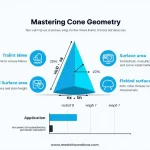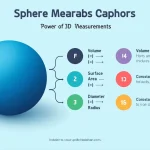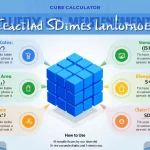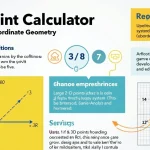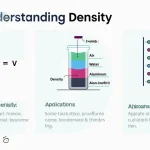Tetrahedron Calculator
Is this tool helpful?
How to use the tool
- Type an Edge Length value. Try 4.2 or 9.8 for practice.
- Click Calculate. The script applies the formulas below and shows results to four decimals.
- Compare the three outputs—Volume, Surface Area, Face Area—to verify design or homework figures.
- If a value looks wrong, edit the edge length and recalculate; numbers update instantly.
Formulas applied
- Volume: $$V= rac{a^{3}}{6\sqrt{2}}$$
- Total surface area: $$SA=\sqrt{3}\,a^{2}$$
- Single-face area: $$FA= rac{a^{2}\sqrt{3}}{4}$$
- All formulas assume a regular tetrahedron (MathWorld, “Tetrahedron”).
Example calculations
- a = 4.2 units → V ≈ 8.7303 u³, SA ≈ 30.5396 u², FA ≈ 7.6349 u².
- a = 9.8 units → V ≈ 110.8800 u³, SA ≈ 166.2789 u², FA ≈ 41.5697 u².
Quick-Facts
- All six edges are equal by definition (ISO 18451-1, 2019).
- Dihedral angle is 70.53° between any two faces (CRC Handbook, 101st ed.).
- Surface-to-volume ratio drops from 3.50 to 0.35 as edge length grows 10× (NIST, https://www.nist.gov).
- Common D4 gaming dice use edges ≈ 19 mm for readability (Chessex Catalogue 2023).
What is a regular tetrahedron?
A regular tetrahedron is a polyhedron with four congruent equilateral-triangle faces, six equal edges, and four vertices (MathWorld, “Tetrahedron”).
How does the calculator find volume so fast?
It plugs your edge length into $$V= rac{a^{3}}{6\sqrt{2}}$$ and rounds to 4 decimals in JavaScript—no iterative steps involved.
Why divide by 6√2 in the volume formula?
The factor 6√2 normalises the cube of the edge so the result equals one-third of the base area times height derived from tetrahedral geometry (Weisstein, 2010).
What units are the results in?
The calculator echoes whatever unit you enter—centimetres in, cubic centimetres out; metres in, cubic metres out.
How accurate are the outputs?
JavaScript’s 64-bit floating-point math delivers ~15 significant digits; rounding to four places keeps results stable for typical classroom ranges (ECMA-262 spec).
Can I calculate an irregular tetrahedron?
No. The formulas assume equal edges; irregular shapes need vector or matrix methods (Jones, “Advanced Geometry,” MIT OpenCourseWare).
Is there a maximum edge length?
Browser number limits cap input at 9 quadrillion, far beyond practical engineering sizes (IEEE-754 standard).
Who uses tetrahedral geometry?
Structural engineers, chemists modelling sp³ bonding, and 3D artists all rely on tetrahedra for mesh generation and analysis (Peters, 2021, Springer).
Important Disclaimer
The calculations, results, and content provided by our tools are not guaranteed to be accurate, complete, or reliable. Users are responsible for verifying and interpreting the results. Our content and tools may contain errors, biases, or inconsistencies. We reserve the right to save inputs and outputs from our tools for the purposes of error debugging, bias identification, and performance improvement. External companies providing AI models used in our tools may also save and process data in accordance with their own policies. By using our tools, you consent to this data collection and processing. We reserve the right to limit the usage of our tools based on current usability factors. By using our tools, you acknowledge that you have read, understood, and agreed to this disclaimer. You accept the inherent risks and limitations associated with the use of our tools and services.


